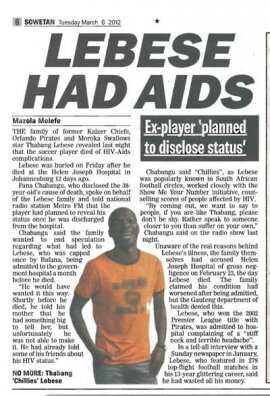

ANALYSIS: Uncritical coverage of Lebese’s death
Kim Johnson
9 March 2012
Uncritical and unquestioning coverage of soccer star Thabang Lebese’s death due to an AIDS-related illness could send public opinion of HIV back to the dark ages.
Despite the fact that soccer star Thabang Lebese’s death was reminiscent of AIDS-related deaths of the 80s and 90s prior to the introduction of effective antiretroviral treatment (ART), none of the major papers that ran with the Lebese story bothered to ask why the former Bafana Bafana midfielder had died of a chronic but manageable condition.
As a result of this half-told story readers might get the impression that HIV is still a killer condition, when in fact studies and experience have proven that if taken correctly ART significantly prolongs the lives of people living with HIV.
But none of the journalists involved bothered to find out whether Lebese had been taking ARVs for any length of time. This amounts to a missed opportunity to reinforce messages that ART is effective and possibly–if Lebese had not been accessing treatment-find out why the star had not sought treatment earlier.
South Africa’s rocky road to free HIV-treatment and recent events such as Lesego Motsepe’s public announcement that she would stop taking ARVs in favour of garlic and beetroot, mean that the life-saving power of ART cannot be stressed enough.
Given Lebese’s involvement in the HIV-awareness campaign “Show me your number”, and his family’s announcement that the soccer star wanted to reveal his status, one might argue that Lebese himself would have favoured more critical coverage of his death. Sadly, the media missed this opportunity to honour his legacy with one final positive, HIV-message.
blog comments powered by Disqus

